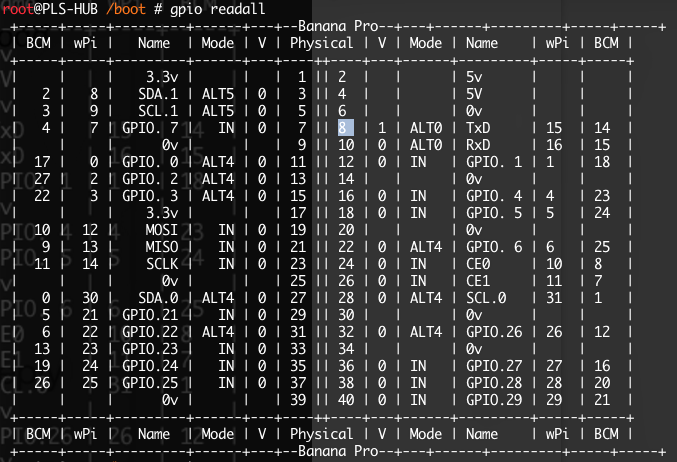@tkaiser,
I knew about that 1st link which i’ve been using as a reference for the correct uart def syntax …
and i posted the output of dmesg | egrep “serial|uart” in my 1st post …
The output would suggest that the four on board uarts are bound to ttySx devices ? so it should work unless the pin allocations in the M1+ fex file is wrong ?
i can use
stty -F /dev/ttySx 9600 ( where x = 0-3)
to set baud rate on each uart port and stty returns without any errors …
if i do the same for ttyS4 - ttyS9
1 root@PLS-HUB ~ # stty -F /dev/ttyS4 9600
stty: /dev/ttyS4: Input/output error
returns I/O error, even though ttyS4 - ttyS9 exists as virtual device in /dev
1 root@PLS-HUB ~ # ls /dev/tty
/dev/tty /dev/tty18 /dev/tty28 /dev/tty38 /dev/tty48 /dev/tty58 /dev/ttyS1 /dev/ttyS2 /dev/ttyS3
/dev/tty0 /dev/tty19 /dev/tty29 /dev/tty39 /dev/tty49 /dev/tty59 /dev/ttyS10 /dev/ttyS20 /dev/ttyS30
/dev/tty1 /dev/tty2 /dev/tty3 /dev/tty4 /dev/tty5 /dev/tty6 /dev/ttyS11 /dev/ttyS21 /dev/ttyS31
/dev/tty10 /dev/tty20 /dev/tty30 /dev/tty40 /dev/tty50 /dev/tty60 /dev/ttyS12 /dev/ttyS22 /dev/ttyS4
/dev/tty11 /dev/tty21 /dev/tty31 /dev/tty41 /dev/tty51 /dev/tty61 /dev/ttyS13 /dev/ttyS23 /dev/ttyS5
/dev/tty12 /dev/tty22 /dev/tty32 /dev/tty42 /dev/tty52 /dev/tty62 /dev/ttyS14 /dev/ttyS24 /dev/ttyS6
/dev/tty13 /dev/tty23 /dev/tty33 /dev/tty43 /dev/tty53 /dev/tty63 /dev/ttyS15 /dev/ttyS25 /dev/ttyS7
/dev/tty14 /dev/tty24 /dev/tty34 /dev/tty44 /dev/tty54 /dev/tty7 /dev/ttyS16 /dev/ttyS26 /dev/ttyS8
/dev/tty15 /dev/tty25 /dev/tty35 /dev/tty45 /dev/tty55 /dev/tty8 /dev/ttyS17 /dev/ttyS27 /dev/ttyS9
/dev/tty16 /dev/tty26 /dev/tty36 /dev/tty46 /dev/tty56 /dev/tty9 /dev/ttyS18 /dev/ttyS28
/dev/tty17 /dev/tty27 /dev/tty37 /dev/tty47 /dev/tty57 /dev/ttyS0 /dev/ttyS19 /dev/ttyS29
root@PLS-HUB ~ #
So i would have thought that this would suggest that all four hardware uarts are accessible ?
but
echo “This is a test” > /dev/ttyS2
Results in nothing being transmitted ? same goes if i use mini com and send data from Arduino … nothing received ?
output of the other command you suggested
1 root@PLS-HUB ~ # cat /proc/tty/driver/serial
serinfo:1.0 driver revision:
0: uart:U6_16550A mmio:0x01C28000 irq:33 tx:0 rx:0
1: uart:U6_16550A mmio:0x01C28800 irq:35 tx:0 rx:0
2: uart:U6_16550A mmio:0x01C29000 irq:49 tx:12 rx:0
3: uart:U6_16550A mmio:0x01C29C00 irq:52 tx:0 rx:0
4: uart:unknown port:00000000 irq:0
5: uart:unknown port:00000000 irq:0
6: uart:unknown port:00000000 irq:0
7: uart:unknown port:00000000 irq:0
8: uart:unknown port:00000000 irq:0
9: uart:unknown port:00000000 irq:0
10: uart:unknown port:00000000 irq:0
11: uart:unknown port:00000000 irq:0
12: uart:unknown port:00000000 irq:0
13: uart:unknown port:00000000 irq:0
14: uart:unknown port:00000000 irq:0
15: uart:unknown port:00000000 irq:0
16: uart:unknown port:00000000 irq:0
17: uart:unknown port:00000000 irq:0
18: uart:unknown port:00000000 irq:0
19: uart:unknown port:00000000 irq:0
20: uart:unknown port:00000000 irq:0
21: uart:unknown port:00000000 irq:0
22: uart:unknown port:00000000 irq:0
23: uart:unknown port:00000000 irq:0
24: uart:unknown port:00000000 irq:0
25: uart:unknown port:00000000 irq:0
26: uart:unknown port:00000000 irq:0
27: uart:unknown port:00000000 irq:0
28: uart:unknown port:00000000 irq:0
29: uart:unknown port:00000000 irq:0
30: uart:unknown port:00000000 irq:0
31: uart:unknown port:00000000 irq:0
root@PLS-HUB ~ #
Again this would suggest that all four uarts are assigned to devices ?
Completely confused as to what the issue could be ?
Cheers
Jay


